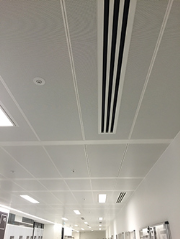Gilberts (Blackpool) has helped Google to keep its London operation and workforce comfortable.
 Gilberts (Blackpool) has helped Google to keep its London operation and workforce comfortable.
Gilberts (Blackpool) has helped Google to keep its London operation and workforce comfortable.
While waiting for the completion of its new one million square feet offices in Kings Cross, central London, the corporation is renting accommodation for 4,500 staff in a building in front of its new site, originally speculatively-built and fully fitted-out for general office accommodation. The higher than average use of IT by Google meant a desire to upgrade the existing air movement and Gilberts was consulted.
Gilberts applied best value principles and has now delivered a solution through which the original grilles have been removed, re-worked, and re-installed, using technology that Gilberts originally developed to help address air quality in the humid environment of the Hong Kong MTR (underground transport system).
Gilberts’ sales director Ian Rogers said: “The original GSL grilles were appropriate for typical office use, as per the design specification, but Google wanted better performance in terms of control over airflow and temperature, because of the spot heat generated from the high number of computers. Google also wanted a more modern, ceiling-free environment. However, modifications had to be undertaken with minimal disruption and remodelling building work.”
Gilberts’ solution, tried and tested in its state-of-the-art test centre at its Blackpool HQ, was to re-use the existing linear ceiling diffusers with the original blades removed and replaced with modified deflectors. The vanes in the new version were originally developed to solve a moisture and humidity issue on the Hong Kong MTR, and now form a core element of Gilberts’ GZL ‘Zipp-Air’ slot diffusers.
The Google diffusers now deliver multi-directional airflow; blades, at 100mm increments instead of the standard 200mm, simultaneously provide more control and greater air throw. A semi-circular air distribution pattern under the diffuser face that allows high induction mixing with the room air and a rapid fall off in discharge velocities, enabling high air change rates can easily be accommodated within normal comfort condition parameters.
Ian Rogers said: “Everyone involved in the project, the main contractor Integra Contracts, the M&E contractors MJ Lonsdale and the consultants Cundells, visited our test centre, where we demonstrated the performance of the original diffusers in a ceiling, as was installed, and then without a ceiling, as Google wanted the areas to be, as it was hoped this would be a viable ‘quick fix’. We also demonstrated our GSFA swirl diffusers - the product of choice if starting from scratch, and then original GSL diffusers with the alternative modified deflector blades. The final option was chosen, as delivering the air movement requirements needed, with the added benefit of re-using the existing products thus saving money, materials, carbon and time.”